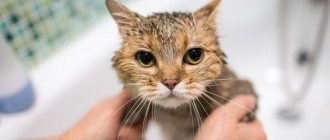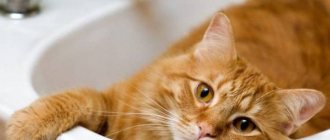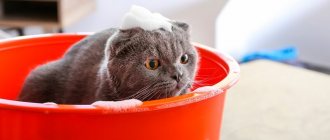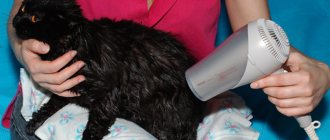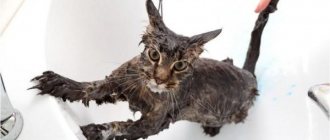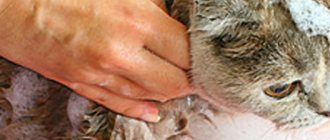Having discovered fleas on a cat, many owners select relatively cheap folk remedies for treatment. In terms of effectiveness, they are often not inferior to expensive and advertised ones, but are less dangerous to the health of the animal.
Tar soap is an excellent option in the fight against external parasites. To successfully use soap, it is important to study its composition, properties and basic rules of use.
Is it suitable for cats?
In addition to special shampoos intended for hair and skin care, there are drugs whose action is aimed at destroying parasites or fungus. Many cat owners refuse pharmaceutical products, preferring tar soap, because... this product has a number of useful properties.
When used correctly, this soap accelerates the process of cell regeneration and relieves irritation of the epidermis. It has anti-inflammatory and antibacterial effects. The smell of a hygiene product can repel parasites, which serves as a prevention of flea infestation.
But tar soap cannot be used regularly for the procedure either. The choice in favor of this product should be made if there is no special means for washing the animal at home.
Pros and cons of this tool
In people, the use of known drugs to kill harmful insects can cause allergies and damage to the respiratory system. Soap with tar differs from such insecticides in a number of advantages:
- it is effective;
- safely;
- it can be used repeatedly;
- the use of such soap does not lead to allergic manifestations or side effects, since it does not contain chemical components or dyes;
- low cost.
Along with significant advantages, tar soap has minor disadvantages:
- a sharp characteristic odor that many people do not like;
- cats behave restlessly when their fur is treated with tar soap, they are able to break out, bite, and scratch;
- Soap is ineffective on insect eggs.
Tar soap effectively kills fleas
Does it help remove fleas?
Soap containing birch tar does not provide a 100% guarantee of killing parasites. The product will only be effective under certain conditions. For example, if a cat has been in contact with another animal that has fleas, then preventive treatment is required immediately after a walk.
It is necessary to bathe the pet. If he was infected, then 1 procedure will be enough. Parasites can be washed or combed out. Benzene, which is contained in tar, is a toxin for insects. It affects the nerve centers of fleas. Therefore, the parasites become lethargic (sedentary).
If a cat has a severe flea infestation, then several treatments will be required to treat head lice. The animal must be soaped and wait 5 minutes. During this time, some of the fleas will leave the fur on their own (will end up in the water), while others will become inactive. The remaining parasites are combed out.
But soap only has a negative effect on adults, and not on their eggs. Therefore, it will be necessary to re-treat in a few days when the nits hatch.
Advantages and disadvantages
The advantages include:
- availability and low price (about 50-60 rubles);
- high efficiency;
- natural composition;
- absence of harmful substances;
- Possibility of use for small kittens.
The disadvantages are the following:
- strong unpleasant odor;
- the need for re-processing;
- complexity of the procedure (animals usually do not want to bathe).
In addition, the product does not act against flea eggs, so additional measures must be taken.
Is it effective against lichen?
Tar reduces the activity of bacterial and fungal microflora, so soap containing this element can be used to treat lichen in cats. To cure an animal, apply foam to the affected area and leave for 15 minutes.
You can also make pasta. You will need to rub the bar, fill it with warm water, and then wait until the crushed particles are completely dissolved. You should get a homogeneous mass. It is applied daily to the lichen, and after 15-20 minutes it is washed off with water.
Which cats is this product suitable for?
Tar flea soap is safe to use on all cats because it is not an insecticide. All kinds of drugs and collars are allowed to be used without harm only for animals older than two months. And with this grandmother’s remedy, known many centuries ago, all furry creatures were effectively treated: kittens, pregnant and lactating females, cats with wounds on the skin.
Sulfur-tar ointment
For a dermatological disease, a veterinarian may recommend sulfur-tar ointment. In addition to tar, it contains substances that will help speed up the process of treating lichen (turpentine, lanolin, sulfur, zinc oxide, salicylic acid, Lysol and petroleum jelly).
Before use, the cat’s hair is not cut. The ointment is applied to the affected area, and also treated 2-3 cm beyond the contour of the lichen (around). Forcibly, i.e. You cannot remove the crusts yourself. The site of infection is treated 1-2 times a day.
In most cases, a positive result is observed on the 7-10th day of treatment. The crusts begin to separate, and the hairline is restored (grows).
Instructions for use
How to use this soap correctly? There are several steps that you can follow to get the most out of the product:
- Apply tar soap thoroughly to the cat's fur until a rich foam forms. Take this matter with special care if you have a furry pet. Be sure to ensure that the product does not get into your cat’s ears or eyes.
- Now spread the tar soap against fleas over the entire coat, not missing even hard-to-reach areas of the body. Don't forget to massage the product into your skin.
- Let the product remain on your pet for several minutes. This is necessary so that the foam has time to saturate the fur, skin and reach all hidden parasites. In the meantime, it’s worth keeping your pet busy so that he doesn’t start licking the tar soap.
- Now you can wash off the product with warm water. At the same time, it is recommended to use a fine-tooth comb to comb out as many fleas as possible from the fur.
This simple instruction can be used not only to rid cats of insects. In the same way, you can get rid of pests from other pets by using tar soap against fleas: your dog or another pet has got them. Remember a little trick. As you know, not all animals love water treatments. And getting rid of fleas can be a real problem for both the owner and his pet. One trick can help here. It is better to start the procedure not in the bathroom itself with a lot of water. At the sight of a shower, cats simply begin to break out. In order not to injure the unfortunate animal, dilute tar soap with a small amount of water and carry out all manipulations in a dry basin or on a towel. And only then, when washing off the foam, can you use water.
Tar soap does not help against fleas instantly. The effectiveness of this grandmother’s remedy lies in the regularity of procedures. Only frequent use of tar soap will rid your pet of the entire population of parasites. How often should you bathe your cat in soapy water? Usually the treatment is repeated after ten days. But you can reduce this period to two days. The more often the better. The result will exceed expectations, and there will be no harm to the cat from tar soap.
Harm and contraindications
Soap containing tar is considered a fairly safe product, but also has contraindications. It is not recommended for washing kittens that are not yet 6 weeks old. You should refrain from using the hygiene product if the cat has an individual intolerance to tar or other components included in its composition.
Soap can be harmful to your cat if the foam gets into your cat's eyes. It will cause pain. To eliminate the irritating factor, the animal's eyes are washed with clean water. If soap gets into the mouth or digestive tract, your pet may experience symptoms of stomach upset. Sometimes he can be lethargic.
If an animal has eaten a lot of soap, then it shows signs of poisoning. In such a situation, you need to take the cat to the veterinarian. Gastric lavage may be required.
Frequent use of soap can cause dermatological problems. Despite the antiseptic, wound-healing effect, the hygiene product dries out the skin. Therefore, with frequent bathing, the cat may experience irritation from drying out of the epidermis.
Precautionary measures
Despite the fact that tar soap rarely causes allergy attacks, before washing it is better to make sure that the cat does not have an individual intolerance to its components. To do this, apply a little product to a part of the body that is inaccessible to the pet, for example, the withers.
If after a day there is no reaction, then you can safely remove fleas from your cat with this soap.
It is better not to get your pet’s head wet at all, but keep it elevated during bathing so that foam does not get into the nose, mouth, ears and eyes. Accidental ingestion of foam may cause stomach upset.
You should not bathe cats with dry and thin skin too often with tar soap. They may experience irritation, peeling and cracking.
The sharp and unpleasant smell of tar soap can lead to dizziness, so it is better to carry out the treatment in well-ventilated areas.
Shampoo
Tar shampoo intended for animals can be purchased at a veterinary pharmacy, pet store or supermarket, i.e. the product is publicly available. This product is often marketed as a flea and tick product. You can choose from:
- Celandine;
- Magic pet;
- Doctor;
- Luxury;
- Degtyarny (Nevskaya cosmetics);
- Home doctor.
The difference between shampoo and soap may be in the composition, but not always. Additional substances, such as dyes or fragrances, are often added to the first product. Not all of them are safe for the animal, because... may cause an allergic reaction.
When choosing between soap and shampoo, you should carefully study the composition. If the cat does not have individual intolerance to the components, then you can use any form of release.
Many owners prefer to use shampoo because... it's easier to apply.
Which soap is better - liquid or solid?
Now on store shelves you can find liquid tar soap in pieces. Each release form has its own advantages and disadvantages, so it is difficult to say which is better. Hard pieces are more common. They contain only natural ingredients, but the disadvantage is that they are inconvenient to use. They don't lather well, so they need to be soaked and prepared in advance.
Soap liquid containing tar has the same properties and effects. It is convenient to use (just press the pump once or several times), but often contains surfactants (surface active substances). They dry out the skin excessively, which is especially noticeable with frequent use.
You can now see the current price of soap and buy it right here from Yandex Market with fast delivery:
How to wash?
The cat can be bathed 2 times a month. Water procedures should be abandoned if the animal:
- pregnant;
- sick;
- was recently vaccinated.
If the pet has just eaten, then it is better to postpone bathing for 2-3 hours.
To make the cat feel comfortable during water procedures, preference should be given to a small bath. You need to lay a rug on its bottom. It will prevent the animal's paws from slipping. Water is drawn up to the level of the pet’s chest. It should be warm, not exceed +38°C.
The cat is lowered into the prepared bath. It is not recommended to collect water while the animal is inside. This bathing option is suitable for pets who love such procedures.
The animal's fur is well moistened with water and then soaped. Shampoo or soap containing tar is immediately applied to the coat. There is no need to pre-dilute the detergent in water. It is not recommended to wet or soap your hair.
For the product to work, it must be left on the fur for 5-10 minutes. When the time is up, the animal is rinsed with clean water. The foam is washed thoroughly. It should not remain on the fur, because... may get on the mucous membrane.
When the water procedure is completed, the cat is wrapped in a dry towel and taken to a warm room. Additionally, you can turn on the heater to prevent your pet from freezing. You should not let the animal out of the warm room until it is dry. Otherwise, there is a risk that the cat will get sick.
Traditional methods of treatment
Folk remedies should be used only after prior consultation with a veterinarian. It must be remembered that such treatment methods may not always be effective, especially in the presence of a significant number of parasites. In order to achieve a positive result, it is recommended to use several methods at once.
Cats may be allergic to some folk remedies. It is important to monitor skin reactions during the procedure. If alarming symptoms occur (redness, itching, rashes, vomiting and diarrhea), you should abandon the chosen method and consult a doctor.
Mechanical method
This method is effective only when used in conjunction with anti-blade treatment. If you do not additionally use any anti-parasite remedies, this procedure will not bring any results. Therefore, before you start combing, it is recommended to treat your pet’s fur with any anti-blade shampoo or tar soap. The procedure should be repeated several times a day.
Algorithm of actions:
- Wear gloves. This is a prerequisite, otherwise you can get some kind of infection from fleas.
- Take a fine-tooth comb and comb the cat's fur against the direction of hair growth.
- Gently comb out the parasites, using your fingers to select the larvae, which most often attach closer to the skin. All fleas should be thrown into a jar of boiling water.
- After combing against the grain, you need to do the same only in the opposite direction (according to growth).
A total of up to 5 procedures may be required. It all depends on the method of removing parasites. Even if fleas are completely eliminated, it is necessary to comb out again after 7 days.
Combing fleas from a cat should be done with a special comb.
The mechanical method is not suitable for everyone. Your pet may not like this method because it takes quite a lot of time. This is especially true for active animals accustomed to constant play.
Tar soap
Tar soap is not only a safe, but also a useful way to get rid of fleas and has an antiseptic and wound-healing effect. To eliminate parasites, it is most convenient to use a liquid product. Of course, the animal may not like soap, since it has a pungent odor, but this method in most cases does not cause adverse reactions.
Tar soap has an antiseptic and anti-inflammatory effect
How to use the product:
- Fill the bathroom with hot water. It should be remembered that a comfortable temperature for a cat is 39–40 degrees.
- Rinse the animal's fur and apply tar soap, evenly distributing it over the entire surface of the body.
- Wait a few minutes and rinse off the foam thoroughly.
- Wrap your pet in a towel. When the fur is dry, comb out the fleas.
Attention! Under no circumstances should soap get into your pet's eyes or mouth. The muzzle area must be treated very carefully.
A friend has a cat who at one time was periodically itching. At first she didn’t attach much importance to it, but then she noticed that the pet had fleas. I decided not to use chemicals and bought tar soap. Its smell, of course, is not for everyone, but it is a very effective remedy. After washing the cat 3 times using this soap, a friend noticed that all the parasites had disappeared. In addition, the cat’s fur became fluffy and soft. This soap can eliminate pathogenic microflora and is especially effective against fungi.
Medicinal herbs
To eliminate this problem, you can use the following herbs:
- Sagebrush. Medicinal raw materials do not have a toxic effect on the body and do not cause allergic reactions. To process one animal, you will need 20 g of raw material, which needs to be filled with 500 ml of water and put on fire. Cook for 10 minutes, then let sit for another hour. Then filter and add 1 drop of lavender essential oil. After this, rinse the pet’s fur with the resulting liquid and wrap it in a towel. Allow the animal to dry and comb it. The procedure must be repeated 2-3 days in a row.
- Tansy. Dry raw materials in the amount of 20 g should be poured with 600 ml of boiling water and allowed to brew for about 2 hours. Then filter, heat slightly (up to 40 degrees) and rinse your pet’s fur. Repeat the procedure 2-3 days in a row. When using this method, it is important to comb out the parasites.
- Celandine. This remedy can provoke an allergic reaction, so using it too often is not recommended. First of all, you need to prepare an infusion. For this, 1 tsp. dry herbs should be poured with 300 ml of boiling water and left for an hour. Then strain the liquid and, moistening a cotton pad in it, treat the pet’s fur. You need to do this for several days in a row. It is important to ensure that the cat does not lick the infusion from the surface of the fur, so it is recommended to use a special collar. After the pet has dried, it is necessary to comb it out.
- Geranium and lavender. The herbs need to be mixed in equal proportions and take 60 g of raw material, which should be poured into 1 liter of water and cooked for a quarter of an hour. Then cool to 40 degrees and filter. Use to rinse the animal for 2-3 days in a row. After the wool has dried, comb it out, as in other cases.
If, when using raw materials, the pet’s itching increases, the cat becomes lethargic and the appetite worsens, then this is considered a manifestation of intolerance to the plant component. In this case, it is recommended to abandon the use of herbs and use another method.
What herbs will help get rid of parasites - photo gallery
Wormwood does not cause allergic reactions
Celandine should be used with caution
Geranium has a pungent odor
Lavender eliminates tissue swelling
Tansy effectively eliminates fleas
Garlic and rules for its use
Garlic is considered one of the most effective remedies that can get rid of the problem in 1-2 times. The only thing that needs to be taken into account is the possible occurrence of allergic reactions in the pet. They appear infrequently, but can cause burning and skin rashes.
Garlic is the most effective flea remedy
Algorithm of actions:
- Peel 6 cloves of garlic and grate them.
- Pour 1 liter of warm (not hot!) water.
- Let it brew for 10 hours, then strain and add 1 tsp. brewer's yeast.
- Mix the liquid thoroughly.
- Dip a cotton pad in the product and rub the resulting medicine into the pet’s fur.
- After a day, bathe the animal with shampoo.
Brewer's yeast can be purchased at the pharmacy
When using garlic and brewer's yeast, it is important to ensure that the resulting liquid does not enter the pet's gastrointestinal tract. To do this, it is strongly recommended to use a collar, otherwise the cat may experience serious complications.
Essential oils
Essential oils can be used for treatment:
- Rosemary. It is most convenient to use this oil for bathing the animal. To do this, you need to fill a basin with warm water and add 2 drops of rosemary ether. Mix everything thoroughly and can be used to bathe your pet. This method is recommended to be combined with the use of tar soap. In some cases, one procedure will be sufficient.
- Geranium and lavender. Pour 2 cups of boiled warm water into a container with a spray bottle and add the indicated essential oils, 1 drop at a time. Shake the contents thoroughly and use to spray your pet's fur 2 times a day. On the second day, comb out.
- Lemon and mint. These essential oils are recommended to be added to cat bathing shampoo. Two drops are enough to achieve results. You should bathe your animal very carefully. It is necessary to ensure that shampoo with oils does not get on the face. After the wool is dry, comb it out.
Attention! Essential oils can only be used in the quantities indicated. In no case should you exceed the dosage, otherwise a severe allergic reaction may occur.
What essential oils can be used - photo gallery
Rosemary essential oil helps relieve inflammation
Geranium essential oil promotes tissue regeneration
Lavender essential oil is effective in the fight against blood-sucking parasites
Peppermint essential oil produces an antiseptic effect
Lemon essential oil repels fleas
Use of salt
Regular table salt can help fight blood-sucking parasites. This remedy is effective and safe and can be used even in weakened animals. You only need to use the product once. It is best to purchase fine salt for these purposes, since it is the easiest way to prepare a solution.
Table salt is a safe method to help eliminate fleas
Algorithm of actions:
- Take 10 liters of warm water into a basin and add 3 tbsp. l. salt. Mix everything thoroughly until all the grains are dissolved.
- Place the cat in the basin, soap it with tar soap and wait a couple of minutes.
- Then rinse off the soap with saline solution.
- Dry the wool thoroughly, then comb it out.
If a cat has severe scratching on its body, the saline solution can cause tingling. Therefore, if your pet has wounds on the skin, it is best to refrain from such a procedure.
Pine sawdust
Pine sawdust has a specific odor that fleas cannot tolerate, so this product is used as an auxiliary treatment method. The raw materials are placed under the pet’s bedding or sewn into it, and also placed in the corners of the living room so that the parasites leave the area faster. It should be understood that pine sawdust is not able to rid an animal of a large number of fleas, so this method is recommended to be combined with those presented above.
Pine sawdust can repel fleas
This method is environmentally friendly and safe for both the cat and the residents of the house. Pine sawdust has a pleasant and light pine aroma, which does not cause discomfort to pets and people, but repels various insects.
Hellebore water
This product is one of the most effective, but at the same time not entirely safe for your pet. If hellebore water gets into the gastrointestinal tract, severe poisoning with subsequent death is possible, so the liquid must be used with extreme caution.
Hellebore water is effective against lice, fleas and lice-eaters
Sequencing:
- Wear gloves and place the animal in the bathtub or on the floor.
- Dip a cotton pad in hellebore water and treat the entire coat with the liquid, except the muzzle and anus.
- Wrap your pet in a towel and wait 15 minutes.
- Then rinse thoroughly with shampoo.
- Repeat the procedure in a week.
Attention! Under no circumstances should hellebore water be applied without wearing gloves, as this product is toxic.
Vinegar to the rescue
Vinegar has been used for decades to combat lice and fleas. To enhance the effect, it is also recommended to use ammonia. Cats really don't like this smell, but the results are worth a try. You need to add 2 tsp to 200 ml of vinegar. ammonia.
Regular table vinegar is suitable for this procedure.
Spray the resulting mixture over the surface of the wool using a spray bottle. Then wrap the animal in an old towel or plastic, leaving the muzzle outside. After 10 minutes, rinse thoroughly with shampoo. Then dry the wool with a hairdryer. As a rule, one procedure is enough.
Ammonia is harmful to parasites
To treat cat hair, you should not use vinegar essence, which is very concentrated and can cause irritation. A regular table version of 6 or 9% is suitable.
Lemon infusion
To get rid of the problem, you can use lemon infusion. To do this, you need to wash 1 citrus fruit and cut it, along with the peel, into small pieces. Then pour 600 ml of hot water and leave for 12 hours. Then filter the liquid and pour it into a spray bottle. Apply to spray wool 1-2 days in a row. After the animal has dried, it needs to be combed thoroughly. If necessary, you can repeat the procedure.
Lemons have an unpleasant aroma for fleas
After combing out fleas, the cat's fur should be washed with shampoo. This is necessary in order to prevent allergic reactions that your pet may experience to citrus fruits.
How to remove fleas without using chemicals - video
Reviews
Svetlana Vasilievna, 46 years old, Moscow:
“At the dacha, the cat picked up shingles somewhere. Due to the lack of opportunity to go to the city, i.e. to a veterinary pharmacy, I had to turn to traditional medicine methods. Apply tar soap foam to the affected area, rub in, and then wash off.
Additionally, after each soaping, I treated it with iodine. In this way, we managed to cure lichen in a week.”
Ivan Markovich, 77 years old, Novosibirsk:
“There were always cats at home, 2-3 each. Therefore, I had to deal with the problem of fleas more than once. When signs of parasites were noticed in one of the pets, everyone was immediately bathed with tar soap.
Now there is one cat living at home, which has access to the street. I also bathe her periodically with tar, but this time with shampoo, because... it is more convenient to use. A positive result is always visible after 1-2 procedures.”
Marina Sergeevna, veterinarian, Petro.
Disinsection of premises
Rules for disinfestation of premises:
- If you have an animal, you need to wash the floors in your house every day. To eliminate flea larvae in an apartment, add vinegar to the water. Use the resulting solution to wash the floors and wipe the furniture and bedding of the animal with a damp cloth. For 1 liter of water you will need 1 tbsp. l. vinegar.
- It is recommended to place fresh wormwood and mint in the corners of the apartment. This smell repels insects.
- To re-treat the room, it is recommended to add chlorine-containing products to the water.
- After getting rid of fleas, the animal's bedding must be thoroughly washed at a temperature of 90 degrees. Then iron it with an iron.
- To prevent the reappearance of fleas, it is recommended to spray the room and furniture with a soda solution. For 1 liter of warm water 1 tbsp. l. facilities.
Fresh mint is a good remedy for killing fleas in an apartment.
Attention! If the animal has a lot of fleas, then professional help may be required to thoroughly disinfest the premises.
What to replace it with?
For bathing adults and kittens, it is better to use special products that are intended for animals. When making them, the pH of the pet's skin is taken into account. When choosing a hygiene product, you should always look at the manufacturer’s information about the age at which a cat can be bathed and any contraindications.
If you don’t have tar shampoo or soap at home, and you can’t purchase a special veterinary remedy, dust soap is a good remedy for parasites and skin diseases. This product allows you to destroy not only fleas, but also their eggs.
Tar shampoo, like soap, has a repulsive odor. It is unpleasant not only to insects, humans, but also to the cat itself. For this reason, you should not keep the animal lathered with this composition for a long time.
After bathing, you should not try to mask the smell of soap with another product, such as perfume. For your pet, this aroma will also be unpleasant and irritating. It is necessary to allow the cat to tidy up its fur on its own (by licking).
Causes and symptoms of fleas in cats
Fleas appear in cats when they are infected by other animals. In this case, there may not be direct contact. Parasite larvae can be carried home on shoes. After getting on the pet’s fur, they quickly hatch and actively reproduce. Fleas can cause dermatitis, in which the cat begins to itch, characteristic rashes and damage to the skin appear. Such parasites feed on the capillary blood of the animal, and their saliva is a strong allergen that provokes the described reactions.
Fleas in cats can multiply quickly and cause itching.
Fleas are very easy to recognize. If they are present, the pet itches all the time and may shake its head. Most cats experience decreased appetite, weight loss, and sleep disturbances. In addition, fleas are carriers of helminths, which provoke severe disturbances in the functioning of the pet’s body. To detect parasites, it is enough to move apart a few hairs. Particular attention should be paid to the withers area; as a rule, there are the most fleas there. The parasite resembles a black or brown miniature midge that jumps high and also moves very quickly.
The flea feeds on the pet's capillary blood
Attention! Don't underestimate the presence of fleas. Such blood-sucking parasites can cause diseases not only in pets, but also in people. At the same time, fleas can carry such dangerous pathologies as typhoid, salmonellosis and hepatitis virus.
Risk factors
The fleas that infect cats live in the grass. From there they jump on warm-blooded animals and feed on their blood. These blood-sucking parasites live on all continents, even Antarctica. A cat can become infected with fleas at any time of the year.
It is important to remember the reasons why a cat is at risk of contracting parasites:
- A cat that goes outside will definitely become infected with fleas. Therefore, you should not let your pet walk on its own.
- Unlike cats, domestic dogs should be walked 2-3 times a day. If a dog brings fleas home, then all other animals will pick them up. All pets should be treated for fleas regularly.
- A person can bring fleas into an apartment on his shoes or outerwear. Only regular treatment with anti-flea products will protect your pet.
- If the cat already had fleas, but the owner did not treat the pet, then the parasites will soon appear again. Fleas lay eggs in animal fur. New parasites can hatch from these eggs at any time.
- Fleas that have already entered the apartment will settle in the thick carpet. All carpets and cat beds should be thoroughly vacuumed.
- Fleas multiply especially actively in the heat, so in the summer you will have to treat your cat several times.
Flea infestations often lead to serious complications that are detrimental to the health of cats. Flea bites always cause severe pain and excruciating itching, and also provoke the development of dangerous diseases.
Complications of flea bites:
- Anemia is a condition in which a cat does not have enough blood due to a large number of parasites. The level of hemoglobin in the blood is greatly reduced. It develops when cats are not treated for fleas. Street animals are most often affected. Very young kittens, as well as weakened, sick and elderly animals can die from anemia.
- Flea dermatitis is an allergic reaction to the saliva of parasites that enters the skin during a bite. The pet experiences severe skin irritation, so the cat constantly licks. Her hair falls out and her skin becomes crusty. Infection easily penetrates damaged skin, which can lead to blood poisoning.
- Infectious diseases - fleas can infect pets with bartonellosis or rickettsia.
- Tapeworms - by licking, a cat can swallow fleas infected with tapeworms. Because of this, worms will begin to multiply in the intestines, the pet’s well-being will worsen, and then it will have to be treated not only for fleas, but also for worms.
Parasites are especially dangerous for pregnant and lactating cats. Fleas can harm not only the mother, but also the future offspring. But during pregnancy and lactation, you cannot treat your cat with anti-flea agents, because they are toxic. Treatment must be carried out before mating.
Up to 200 fleas can live on one cat. A caring owner should treat pets for parasites 4 times a year - every 3 months. If your cat has fleas, you need to carry out additional treatment.
We recommend the article: Heat in cats: features, symptoms, deviations from the norm
Difficulties in diagnosis and choice of direction of examination and treatment
The difficulty of diagnosing lichen lies in its insidiousness. The disease can go undetected for quite a long time, especially in long-haired cats. Kittens, young animals under one year old and pregnant cats, furry cats with weakened immune systems, animals with tumors, and pets infected with parasites are most susceptible to the disease.
To determine what kind of problem an animal has: dermatitis, allergies or lichen, you will need qualified help. It is necessary to take a number of tests and undergo an examination with your pet. Such types of research as laboratory and instrumental are common. The methods of collecting material and the type of examination will be prescribed by a veterinary clinic specialist.
Composition, effectiveness and beneficial properties
The drug contains the following ingredients:
- Birch tar. Natural antiseptic. Helps destroy pathogenic organisms and fungi. No insects can tolerate this smell and die from exposure to tar.
- Sodium salts. They normalize the water balance of the skin and help in the treatment of dermatitis.
- Phenol, cresol, acids and alkalis. They “burn out” the parasites and do not give them any chance of survival.
The content of birch tar in soap is no more than 10%. Even through the packaging you can smell the strong smell of soap. The aroma of tar is safe for humans.
Additional properties and distinctive features of the tar preparation:
- Brown color;
- dries hair and fur;
- helps with seborrhea and scabies, soothe itching and relieve inflammation;
- has a wound-healing and antibacterial effect;
- does not foam well;
- relieves itching after insect bites.
The low price determines the popularity of the drug, and one piece is enough for several baths for a medium-sized animal. This product can be used as an alternative to expensive synthetic insecticides. If the animal has too many parasites, you can use special anti-flea preparations along with soap.
Folk anti-flea remedies
The optimal choice for combating parasites in a nursing female remains traditional methods that have been tested over the years and have proven their safety. The desired result is achieved after applying:
- A mixture of baby shampoo and tincture of milk thistle or yarrow. To prepare the product, take 50 g of a washing product and a tincture of a medicinal plant, and dissolve the mixture in 400 ml of boiling water. The animal is bathed in the cooled mixture, the foam is left on the fur for 15 minutes, then washed off.
- Tinctures of dried tansy and bitter wormwood. Take 50 g of each herb, pour 1 liter of boiling water and leave for 3.5 hours. Then the infusion is strained and additionally diluted with 500 ml of warm liquid. The resulting medicinal solution is wiped over the animal's fur or doused. After a quarter of an hour, the cat is washed with the usual shampoo and dried as usual.
- Tinctures from wormwood seeds. To prepare it, 2 tbsp. l. seeds of a pungently smelling plant are poured with boiling water, left for 4 hours, and then the cat is washed with the addition of laundry soap.
If the pet owner is afraid to carry out even such treatment, then the only remaining method of combating parasites is manual combing. A comb with fine teeth and rounded ends is passed over the entire body of the animal, selecting fleas and crushing them.
Parasites are easy to distinguish on the skin: they look like small black dots. The situation is more difficult with flea eggs - they are smaller in size and almost invisible, but if you do not comb them out, then in a week the pet will again be covered in parasites.
A nursing cat needs care and health protection much more than other pets, so treatment for fleas should not be delayed. At the same time, the product for antiparasitic treatment is selected to be safe and natural, so that neither the female nor the cubs feel any side effects.
What else is worth knowing?
There are some nuances and secrets of using tar soap:
- Regularity of processing, as mentioned above. A single procedure will not bring any results.
- If there are other pets in the house and no fleas were noticed on them, then they still need to be “treated” with tar soap. Sooner or later, insects may appear on uninfected animals. But the tar will scare them away.
- Tar soap against fleas should be used not only when bathing a cat. It is recommended to treat the entire apartment with this product: carpets, floors, areas under sofas and baseboards, and other hard-to-reach areas.
- Pets need to change their bedding periodically. It would also be a good idea to thoroughly clean the areas where cats spend a lot of time using tar soap.


